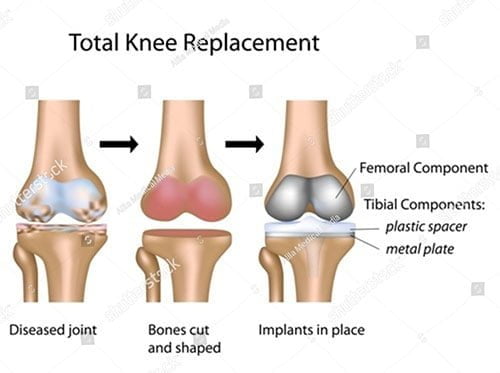PEEK’s efficacy in spinal fusion procedures is well known as this point, but it is also quickly emerging as a frontline option for orthopedic trauma implants. Given the stress placed on bones, as well as the delicate nature of a bone injury, these implants must provide a rare set of physical properties. No other biomaterial does this as well as PEEK, which is why it is quickly replacing metal implants in many orthopedic procedures.
Why is PEEK ideal for orthopedic trauma implants
Orthopedic trauma implants are required when damaged bone must be replaced or supported, at least long enough for the tissue to heal. Bone tissue is constantly exposed to stress, and occasionally very high levels of mechanical stress. As such, orthopedic trauma implants must demonstrate material properties similar to bone to ensure a steady recovery following surgery.
PEEK is a natural fit for the orthopedics field because it offers those favorable properties. After all, PEEK was first proven in some of the toughest settings imaginable, like inside rockets and in downhole oil & gas equipment. If it can handle the extreme physical forces that exist in these settings, then it is more than capable of withstanding the forces that come with stabilizing bone. Here are some additional reasons why PEEK is a frontline choice for orthopedic trauma implants:
1. PEEK behaves like bone – This is the primary advantage that PEEK orthopedic trauma implants offer, compared to all other implant biomaterials. PEEK is not metal, but a semi-crystalline polymer, which means it has a degree of elasticity that most metals do not have.
Elasticity is a valuable trait to have in a trauma implant, and especially for lower body trauma implants. With elasticity usually comes fatigue strength, which is among the most important properties to have in a trauma fixation implant.
Trauma fixation implants take over some of the load-sharing from the damaged bone, so they must withstand the repetitive stress that comes with movement. Materials with a higher fatigue strength are better equipped to do this, as they will maintain their shape and material properties under constant pressure.
It’s important to note that PEEK is a load-sharing material, and not a load-bearing material, like metal. This means that native bone is still appropriately stimulated by micro movement, and it will better maintain its mineral density as a result. Compare this to titanium and other metal implants, which may reduce the integrity of neighboring bone due to bearing too much weight.
Orthopedic trauma implants are designed to support the function of neighboring bone and PEEK does this better than any other biomaterial.
2. Modifiable radiolucency – Regular medical imaging is required in many patients who have received an implant, and medical practitioners rely on it to verify the implant’s position. Frequent imaging helps physicians spot emerging complications before they become a serious matter.
In some instances, it’s more helpful for the implant to provide a high degree of image contrast, while in others, completely radiolucency is required. For example, most medical teams prefer low contrast materials for spinal implants, as it’s easier to see if the implant is properly interfacing with adjacent tissues. As the spine is a delicate structure, medical teams need to see as much of the surrounding tissue as possible. In many trauma fixation devices, though, the tissues around the implant aren’t as critical. In this case, it’s better for the implant to provide greater image contrast, so it can be studied more closely.
PEEK can work with both approaches, as it is a highly modifiable material. In its natural, unfilled state, PEEK is a completely radiolucent material, producing no image scattering on X-rays, CT or MRI scans. When it is augmented with specialty additives, like barium sulfate, though, PEEK is much more visible on medical images.
3. Easier to revise – Orthopedic trauma implants occasionally have to be removed or revised, and that’s a challenge with metal implants, at least compared to PEEK. That’s because PEEK implants experience less bone-on growth than metal implants do. When additional bone tissue must be accounted for during the revision process, it’s more difficult to make the necessary adjustments. PEEK implants do not fuse with bone as readily, so they are easier to adjust during revision surgeries.
4. Resists wear and impact forces – PEEK exhibits a low co-efficient of friction and excellent wear resistance. PEEK’s resistance to wear can be enhanced further with certain fillers and additives, so it is a natural choice for joint replacement implants. PEEK also possesses impressive impact resistance, which is ideal for lower body implant applications.
5. Lightweight – PEEK is much lighter and more flexible than metal, which makes it easier for medical practitioners to preserve their patient’s comfort and flexibility. PEEK’s weight advantage means it also has one of the best strength-to-weight ratios among all biomaterials.
6. Full biocompatibility – PEEK’s biocompatibility has been soundly proven. Multiple studies show that PEEK is not cytotoxic, genotoxic or immunogenic, and PEEK’s impact on neighboring tissues is minimal.
Orthopedic trauma implants need to withstand repeated impact and wear forces over many months or even years. It takes a quality biomaterial to provide that, and PEEK is unmatched in this regard. Its fatigue strength, resiliency, wear resistance and bone-like flexibility make it ideal for orthopedic trauma implants.

